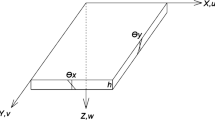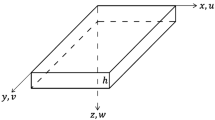The problem on constructing new time-effective characteristics of a linear viscoelastic body is considered. The initial medium is modeled as a viscoelastic composite. One its part has properties determined by time-effective moduli of the Lagrangian type, but the other part has properties determined by moduli of the Castigliano type. This model makes it possible to employ the methods of mechanics of composite materials, for example, to formulate the effective Voigt and Reuss moduli and to construct iterative transformations narrowing the Voigt and Reuss fork. These transformations are constructed in such a way that, at each iteration, the inequalities following from the minimum total potential energy principle and the theorem of complementary work are satisfied for the effective moduli. It is shown that, at each moment of time t, the sequences of iteratively transformed Voigt and Reuss moduli converge to the same limit, equal to the geometric mean of their initial values. By the example of the problem on bending of a viscoelastic plate, the approximate solutions obtained on the basis of the new time-effective characteristics found, are compared with an analytical solution. Their good agreement points to a high accuracy of the approximate solutions.











Similar content being viewed by others
References
A. A. Il’yushin, “Metod of approximations for solving problems of the linear theory of thermoviscoelasticity,” Polym. Mech., No. 2, 210-221 (1968).
A. A. Ilyushin and B. E. Pobedrya, Fundamentals of the Mathematical Theory of Thermoviscoelasticity [in Russian], M. Nauka, (1970).
V. I. Malyi and N. A. Trufanov, “Method of quasi-constant operators in the theory viscoelasticity piecewise linear materials,” Deform. Razrush. Strukturno Neodnorod. Mater. Konstr., Sb. Nauchn. Tr., Sverdlovsk, UrО RAN, 78-85 (1989).
V. I. Malyi and N. A. Trufanov, “Method of quasi-constant operators in the theory of viscoelasticity of anisotropic nonaging materials,” Izv. AN SSSR, Mekh. Tverd. Tela, No. 6, 148-154 (1987).
V. P. Matveenko, I. E. Troyanovskii, and G. S. Tsaplin, “Constructing solutions to the problems of elasticity theory as series in degrees of elastic constants and their application to viscoelasticity,” Prikl. Matem. Mekh., 60, Iss. 4, 651-659 (1996).
V. P. Matveenko, “On the method of solving the problem on joining in the form of a series in degrees of Volterra operators,” in “Boundary-value problems of elasticity and viscoelasticity,” Sverdlovsk, UNC AN SSSR, 112-114 (1985).
R. Shepery, “Viscoelastic properties of composite materials,” Mechanics of Composite Materials [Russian translation]. 2, M., Mir, 102-195 (1978).
L. E. Mal’tsev and A. I. Kreknin, “Direct solution of viscoelasticity problems,” Polym. Mech., No. 4, 510-516 (1977).
A. D. Kovalenko and A. A. Kilchinskii, “On the method of variable moduli in problems of linear hereditary elasticity,” Prikl. Mekh., 6, No. 12, 27-34 (1970).
A. A. Svetashkov, “Time-effective moduli of a linear viscoelastic body,” Mech. Compos. Mater., 36, No. 1, 19-36 (2000).
A. A. Svetashkov, N. A. Kupriyanov, and K. K. Manabaev, “An approximate algorithm for solving the problems of linear viscoelasticity,” Vychisl. Mekh. Splosh. Sred., 5, No. 3, 292-299 (2012).
R. M. Christensen, Mechanics of Composite Materials, John Wiley & Sons, New York–Chichester–Brisbane–Toronto (1979).
V. E. Pobedrya. Mechanics of Composite Materials [in Russian], M., Izd MGU (1984).
E. Beckenbach and R. Bellman, Inequalities, ed. V. I. Levin [Russian translation], М. Komkniga, (2007).
A. A. Svetashkov, J. Miciсski, M. S. Pavlov and A. A. Vakurov, “Algorithm of iterative transformation for effective moduli of multicomponent isotropic composite,” IOP Conf. Ser., Mat. Sci. and Eng., 177, 012094 (2016).
A. Ya. Gol’dman, Strength of Constructional Plastics [in Russian], L. Mashinostroenie (1979).
Yu. N. Rabotnov, Elements of Hereditary Mechanics of Solids [in Russian], M., Nauka, (1977).
V. I. Malyi and N. A. Trufanov, “Quasi-constant operators in the theory of viscoelasticity of nonaging materials,” Izv. AN SSSR, Mekh. Tverd. Tela, No.1, 77-86 (1980).
N. A. Trufanov, “On quasi-constant viscoelastic operators of polymer composite materials,” Behaviour of Deformable Continuous Media, Sverdlovsk, UrО АN SSSR, 14-22 (1990).
A. A. Svetashkov and N. A. Kupriyanov, “Estimating the calculation error of the stress-strain state of linear – viscoelastic bodies with time-effective moduli,” Fiz. Mezomekh., 14, No.1, 101-106 (2011).
Author information
Authors and Affiliations
Corresponding author
Additional information
Translated from Mekhanika Kompozitnykh Materialov, Vol. 55, No. 5, pp. 969-996, September-October, 2019.
Rights and permissions
About this article
Cite this article
Svetashkov, A.A., Fok, S.C., Kupriyanov, N.A. et al. Modification of the Time-Effective Moduli of Viscoelastic Bodies. Mech Compos Mater 55, 667–686 (2019). https://doi.org/10.1007/s11029-019-09843-8
Received:
Revised:
Published:
Issue Date:
DOI: https://doi.org/10.1007/s11029-019-09843-8




